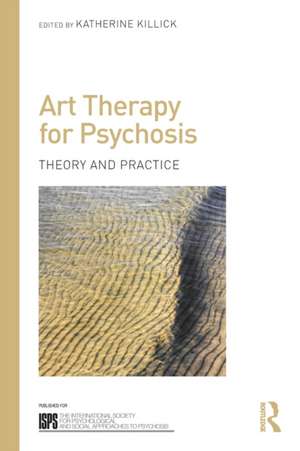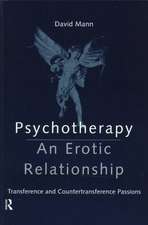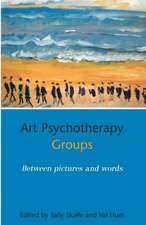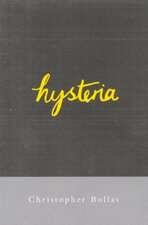Art Therapy for Psychosis: Theory and Practice: The International Society for Psychological and Social Approaches to Psychosis Book Series
Editat de Katherine Killicken Limba Engleză Paperback – 28 feb 2017
The contributors present a diverse range of current theoretical perspectives on the subject, derived from the fields of neuroscience, phenomenology and cognitive analytic theory, as well as from different schools of psychoanalysis. Collectively, they offer insights into the specific potentials of art therapy as a psychotherapeutic approach to psychosis, and describe some of the specialised approaches developed with individuals and with groups over the past 20 years. Throughout the book, the meaning and relevance of art-making as a medium for holding and containing unbearable, unthinkable and unspeakable experiences within the psychotherapeutic setting becomes apparent. Several of the chapters present detailed illustrated case studies which show how making visual images with an appropriately trained art psychotherapist can be a first step on the path into meaningful relatedness.
This book offers fresh insights into the nature of psychosis, the challenges encountered by clinicians attempting to work psychotherapeutically with people in psychotic states in different settings, and the potentials of art therapy as an effective treatment approach. It will be essential reading for mental health professionals who work with psychosis, including psychiatrists, psychoanalysts, psychotherapists and arts therapists, and those in training.
Full colour versions of the illustrations can be viewed at http://isps.org/index.php/publications/book-series/publication-photos
Please see p. ix of the book for details of how to access them.
| Toate formatele și edițiile | Preț | Express |
|---|---|---|
| Paperback (1) | 371.55 lei 6-8 săpt. | |
| Taylor & Francis – 28 feb 2017 | 371.55 lei 6-8 săpt. | |
| Hardback (1) | 1412.69 lei 6-8 săpt. | |
| Taylor & Francis – 28 feb 2017 | 1412.69 lei 6-8 săpt. |
Din seria The International Society for Psychological and Social Approaches to Psychosis Book Series
-
 Preț: 356.45 lei
Preț: 356.45 lei - 5%
 Preț: 232.85 lei
Preț: 232.85 lei - 5%
 Preț: 231.93 lei
Preț: 231.93 lei - 5%
 Preț: 232.22 lei
Preț: 232.22 lei -
 Preț: 345.07 lei
Preț: 345.07 lei -
 Preț: 303.89 lei
Preț: 303.89 lei - 5%
 Preț: 232.63 lei
Preț: 232.63 lei - 5%
 Preț: 940.24 lei
Preț: 940.24 lei - 5%
 Preț: 231.93 lei
Preț: 231.93 lei - 5%
 Preț: 231.90 lei
Preț: 231.90 lei - 5%
 Preț: 454.58 lei
Preț: 454.58 lei - 5%
 Preț: 1348.12 lei
Preț: 1348.12 lei - 5%
 Preț: 354.36 lei
Preț: 354.36 lei - 5%
 Preț: 335.67 lei
Preț: 335.67 lei - 5%
 Preț: 318.11 lei
Preț: 318.11 lei - 5%
 Preț: 1037.43 lei
Preț: 1037.43 lei - 5%
 Preț: 420.67 lei
Preț: 420.67 lei - 5%
 Preț: 304.15 lei
Preț: 304.15 lei - 5%
 Preț: 336.57 lei
Preț: 336.57 lei - 5%
 Preț: 371.73 lei
Preț: 371.73 lei - 5%
 Preț: 330.27 lei
Preț: 330.27 lei - 5%
 Preț: 387.10 lei
Preț: 387.10 lei - 5%
 Preț: 1221.93 lei
Preț: 1221.93 lei - 5%
 Preț: 1095.75 lei
Preț: 1095.75 lei - 5%
 Preț: 328.45 lei
Preț: 328.45 lei - 5%
 Preț: 965.91 lei
Preț: 965.91 lei - 5%
 Preț: 332.06 lei
Preț: 332.06 lei - 5%
 Preț: 1091.19 lei
Preț: 1091.19 lei - 5%
 Preț: 1346.31 lei
Preț: 1346.31 lei - 5%
 Preț: 379.60 lei
Preț: 379.60 lei
Preț: 371.55 lei
Preț vechi: 391.10 lei
-5% Nou
Puncte Express: 557
Preț estimativ în valută:
71.09€ • 74.23$ • 58.84£
71.09€ • 74.23$ • 58.84£
Carte tipărită la comandă
Livrare economică 04-18 aprilie
Preluare comenzi: 021 569.72.76
Specificații
ISBN-13: 9781138792104
ISBN-10: 1138792101
Pagini: 224
Ilustrații: 52
Dimensiuni: 156 x 234 x 14 mm
Greutate: 0.18 kg
Ediția:1
Editura: Taylor & Francis
Colecția Routledge
Seria The International Society for Psychological and Social Approaches to Psychosis Book Series
Locul publicării:Oxford, United Kingdom
ISBN-10: 1138792101
Pagini: 224
Ilustrații: 52
Dimensiuni: 156 x 234 x 14 mm
Greutate: 0.18 kg
Ediția:1
Editura: Taylor & Francis
Colecția Routledge
Seria The International Society for Psychological and Social Approaches to Psychosis Book Series
Locul publicării:Oxford, United Kingdom
Public țintă
Postgraduate, Professional, and Professional Practice & DevelopmentCuprins
Introduction: Places for the Mind to Heal 1. The Matrix of the Mind, the Networks of the Brain, and the Principle of Transformation in Art Therapy for Psychosis 2. Psychodynamic art therapy for psychoses: progressive mirror drawing and other sensorial integration techniques 3. Shaping Consciousness: Phenomenological Art Therapy with Psychotic Adults 4. The Structured Studio Setting: an Ontological Dimension in Art Therapy with Psychosis using the concept of Body Image as Structuring Function 5. A Lacanian Perspective on Art Therapy with Psychotic Patients 6. The Side-by-Side Approach in art therapy for psychosis: deflation and empowerment within the therapeutic relationship 7. The Three Headed Girl: The Experience of Dialogical Art Therapy Viewed from Different Perspectives 8. An Exploration of Art Therapy Process with a Detainee diagnosed with Schizophrenia in a Correctional Facility with reference to the use of the Comic Strip
Notă biografică
Katherine Killick trained as an art therapist and a psychoanalytic psychotherapist. She is a Training Analyst of the Society of Analytical Psychology and a Training and Supervising Analyst of the British Jungian Analytic Association working in private practice. She developed a specialised art-psychotherapeutic approach to psychosis and has published widely in this area. She is co-editor of Art, Psychotherapy and Psychosis with Joy Schaverien and contributes to various clinical trainings in art psychotherapy and Jungian psychoanalysis.
Recenzii
"This book represents a compelling case for contemporary art therapy to have a substantive place in community psychiatry for people who experience psychosis. It contains an impressive range of international contributions with detailed clinical and theoretical accounts, some by psychiatrists.
The book deserves careful attention from practitioners of all mental health disciplines who work with psychosis." - Dr Brian Martindale, Psychiatrist and Psychotherapist, Past Chair of the International Society for Psychological and Social Approaches to Psychosis, Honorary President of the EFPP, Honorary Member of the World Psychiatric Association
"Art therapy began in studios in asylums, many of which housed people experiencing psychosis. It’s come a long way since then. This book shows how, bringing a welcome contemporary and international perspective to art therapy with this client population. Practitioners draw on different kinds of theoretical scaffolding – from phenomenology and cognitive analytical therapy to neurophysiology and psychoanalysis – to develop their approach, unpack how making art becomes a ‘healing agent’ and show how the context and relationship within which this occurs is another. The book shows just how much art therapy now has to offer to the care and treatment of people prone to psychotic states." - Andrea Gilroy, Emeritus Reader in Art Psychotherapy, Goldsmiths, University of London, UK
"This book represents a compelling case for contemporary art therapy to have a substantive place in community psychiatry for people who experience psychosis. It contains an impressive range of international contributions with detailed clinical and theoretical accounts, some by psychiatrists.
The book deserves careful attention from practitioners of all mental health disciplines who work with psychosis."
- Dr Brian Martindale, Psychiatrist and Psychotherapist, Past Chair of the International Society for Psychological and Social Approaches to Psychosis, Honorary President of the EFPP, Honorary Member of the World Psychiatric Association
"Art therapy began in studios in asylums, many of which housed people experiencing psychosis. It’s come a long way since then. This book shows how, bringing a welcome contemporary and international perspective to art therapy with this client population. Practitioners draw on different kinds of theoretical scaffolding – from phenomenology and cognitive analytical therapy to neurophysiology and psychoanalysis – to develop their approach, unpack how making art becomes a ‘healing agent’ and show how the context and relationship within which this occurs is another. The book shows just how much art therapy now has to offer to the care and treatment of people prone to psychotic states."
- Andrea Gilroy, Emeritus Reader in Art Psychotherapy, Goldsmiths, University of London, UK
"I felt touched and inspired by the case narratives that illustrate the role of art therapy in helping patients recover their ability for communication and engagement with others, which is usually profoundly compromised by intolerable psychotic anxieties.
The book powerfully conveys the capacity for art therapy to minimize the requirement for forms of interpersonal relating that are to a greater or lesser extend impossible in psychotic states."
-Swapna Kongara, Psychoanalytic Psychotherapy Journal
The book deserves careful attention from practitioners of all mental health disciplines who work with psychosis." - Dr Brian Martindale, Psychiatrist and Psychotherapist, Past Chair of the International Society for Psychological and Social Approaches to Psychosis, Honorary President of the EFPP, Honorary Member of the World Psychiatric Association
"Art therapy began in studios in asylums, many of which housed people experiencing psychosis. It’s come a long way since then. This book shows how, bringing a welcome contemporary and international perspective to art therapy with this client population. Practitioners draw on different kinds of theoretical scaffolding – from phenomenology and cognitive analytical therapy to neurophysiology and psychoanalysis – to develop their approach, unpack how making art becomes a ‘healing agent’ and show how the context and relationship within which this occurs is another. The book shows just how much art therapy now has to offer to the care and treatment of people prone to psychotic states." - Andrea Gilroy, Emeritus Reader in Art Psychotherapy, Goldsmiths, University of London, UK
"This book represents a compelling case for contemporary art therapy to have a substantive place in community psychiatry for people who experience psychosis. It contains an impressive range of international contributions with detailed clinical and theoretical accounts, some by psychiatrists.
The book deserves careful attention from practitioners of all mental health disciplines who work with psychosis."
- Dr Brian Martindale, Psychiatrist and Psychotherapist, Past Chair of the International Society for Psychological and Social Approaches to Psychosis, Honorary President of the EFPP, Honorary Member of the World Psychiatric Association
"Art therapy began in studios in asylums, many of which housed people experiencing psychosis. It’s come a long way since then. This book shows how, bringing a welcome contemporary and international perspective to art therapy with this client population. Practitioners draw on different kinds of theoretical scaffolding – from phenomenology and cognitive analytical therapy to neurophysiology and psychoanalysis – to develop their approach, unpack how making art becomes a ‘healing agent’ and show how the context and relationship within which this occurs is another. The book shows just how much art therapy now has to offer to the care and treatment of people prone to psychotic states."
- Andrea Gilroy, Emeritus Reader in Art Psychotherapy, Goldsmiths, University of London, UK
"I felt touched and inspired by the case narratives that illustrate the role of art therapy in helping patients recover their ability for communication and engagement with others, which is usually profoundly compromised by intolerable psychotic anxieties.
The book powerfully conveys the capacity for art therapy to minimize the requirement for forms of interpersonal relating that are to a greater or lesser extend impossible in psychotic states."
-Swapna Kongara, Psychoanalytic Psychotherapy Journal
Descriere
Art Therapy for Psychosis presents innovative theoretical and clinical approaches to psychosis that have developed in the work of expert clinicians from around the world. It draws on insights that have emerged from decades of clinical practice to explain why and how specialised forms of art therapy constitute a particularly appropriate psychotherapeutic approach to psychosis. .
























